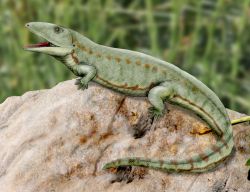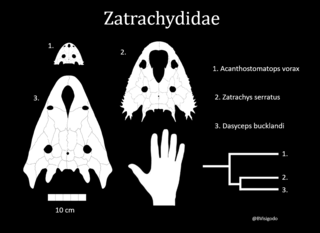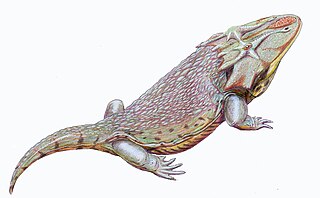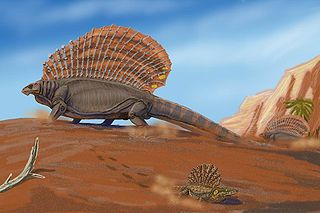
"Labyrinthodontia" is an informal grouping of extinct predatory amphibians which were major components of ecosystems in the late Paleozoic and early Mesozoic eras. Traditionally considered a subclass of the class Amphibia, modern classification systems recognize that labyrinthodonts are not a formal natural group (clade) exclusive of other tetrapods. Instead, they consistute an evolutionary grade, ancestral to living tetrapods such as lissamphibians and amniotes. "Labyrinthodont"-grade vertebrates evolved from lobe-finned fishes in the Devonian, though a formal boundary between fish and amphibian is difficult to define at this point in time.

Cacops, is a genus of dissorophid temnospondyls from the Kungurian stage of the early Permian of the United States. Cacops is one of the few olsoniforms whose ontogeny is known. Cacops fossils were almost exclusively known from the Cacops Bone Bed of the Lower Permian Arroyo Formation of Texas for much of the 20th century. New material collected from the Dolese Brothers Quarry, near Richards Spur, Oklahoma in the past few decades has been recovered, painting a clearer picture of what the animal looked and acted like.

Dissorophidae is an extinct family of medium-sized temnospondyls that flourished during the late Carboniferous and early Permian periods. The clade is known almost exclusively from North America.

Temnospondyli or temnospondyls is a diverse ancient order of small to giant tetrapods—often considered primitive amphibians—that flourished worldwide during the Carboniferous, Permian and Triassic periods, with fossils being found on every continent. A few species continued into the Jurassic and Early Cretaceous periods, but all had gone extinct by the Late Cretaceous. During about 210 million years of evolutionary history, they adapted to a wide range of habitats, including freshwater, terrestrial, and even coastal marine environments. Their life history is well understood, with fossils known from the larval stage, metamorphosis and maturity. Most temnospondyls were semiaquatic, although some were almost fully terrestrial, returning to the water only to breed. These temnospondyls were some of the first vertebrates fully adapted to life on land. Although temnospondyls are amphibians, many had characteristics such as scales and large armour-like bony plates (osteoderms) that generally distinguish them from the modern soft-bodied lissamphibians.

Zatracheidae is a family of Late Carboniferous and Early Permian temnospondyls known from North America and Europe. Zatracheidids are distinguished by lateral (sideways) bony protuberances of the quadratojugal bone of the skull, and a large opening in the snout called the internarial fontanelle that is bordered by enlarged premaxillae. The skull is flattened, with small orbits or eye sockets set far back. The opening in the snout may have housed a gland for producing a sticky substance so that prey would adhere to the tongue. If so, this indicates that these animals spent a large part of their time on land.

Platyhystrix is an extinct temnospondyl amphibian with a distinctive sail along its back, similar to the unrelated synapsids, Dimetrodon and Edaphosaurus. It lived during the boundary between the latest Carboniferous and earliest Permian periods throughout what is now known as the Four Corners, Texas, and Kansas about 300 million years ago.

Cheliderpeton is an extinct genus of temnospondyl amphibian. It lived during the Early Permian in what is now Europe. Fossils have been found from the Ruprechtice horizon of the Intrasudetic Basin of Bohemia in the Czech Republic, as well as the Saar-Nahe Basin of southwestern Germany. Cheliderpeton had a 16 cm skull, and reached about 65 cm in length.

Dasyceps is an extinct genus of zatracheidid temnospondyl from the early Permian of England.

Trematopidae is a family of dissorophoid temnospondyls spanning the late Carboniferous to the early Permian. Together with Dissorophidae, the family forms Olsoniformes, a clade comprising the medium-large terrestrial dissorophoids. Trematopids are known from numerous localities in North America, primarily in New Mexico, Oklahoma, and Texas, and from the Bromacker quarry in Germany.

Acroplous is an extinct genus of dvinosaurian Temnospondyli within the family Eobrachyopidae.
Pariotichus is an extinct genus of gymnarthrid microsaurs from the early Permian of Texas.

Trimerorhachis is an extinct genus of dvinosaurian temnospondyl within the family Trimerorhachidae. It is known from the Early Permian of the southwestern United States, with most fossil specimens having been found in the Texas Red Beds. The type species of Trimerorhachis, T. insignis, was named by American paleontologist Edward Drinker Cope in 1878. Cope named a second species from Texas, T. mesops, in 1896. The species T. rogersi and T. greggi are also from Texas, and the species T. sandovalensis is from New Mexico.

The Amphibamidae are an ancient family of dissorophoid temnospondyls known from Late Carboniferous-Early Permian strata in the United States.

Adamanterpeton is a genus of Edopoid Temnospondyl within the family Cochleosauridae. The type species A. ohioensis was named in 1998 and is currently the only known species within this genus. Adamanterpeton is rare in the Linton vertebrate assemblage, with other amphibians like Sauropleura, Ophiderpeton, and Colosteus being more common. Unlike other Linton vertebrates, Adamanterpeton may have been adapted to a terrestrial lifestyle.
Parioxys is an extinct genus of temnospondyl amphibian from the Early Permian of Texas.

Vigilius is an extinct genus of brachyopid temnospondyl amphibian from the Triassic of Arizona. It is known from the single type species Vigilius wellesi.

The Red Beds of Texas and Oklahoma are a group of Early Permian-age geologic strata in the southwestern United States cropping out in north-central Texas and south-central Oklahoma. They comprise several stratigraphic groups, including the Clear Fork Group, the Wichita Group, and the Pease River Group. The Red Beds were first explored by American paleontologist Edward Drinker Cope starting in 1877. Fossil remains of many Permian tetrapods have been found in the Red Beds, including those of Dimetrodon, Edaphosaurus, Seymouria, Platyhystrix, and Eryops. A recurring feature in many of these animals is the sail structure on their backs.
The Waggoner Ranch Formation is a geologic formation in northern Texas. It preserves fossils dating back to the Artinskian to Kungurian stages of the Permian period.

Amphibamiformes is an unranked clade with Dissorophoidea created by Schoch (2018). It encompasses all of the taxa traditionally considered to be "amphibamids", branchiosaurids, and hypothetically lissamphibians under the traditional temnospondyl hypothesis of lissamphibian origins. These taxa are typically small-bodied dissorophoids and form the sister group to Olsoniformes, which comprises dissorophids and trematopids.




















